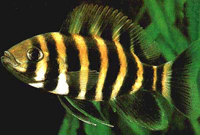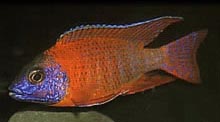|
What do I need
Cichlids
for
by
Andrew Boyd
This Issue of Tank Talk is almost totally bereft of mention of one of my favourite groups of fishes, the Cichlids. In the interests of fairness, and to fill up a little space, I will respond to a perennial query posed at the library table or during club auctions.
"What do I want those things for?"
 Let me state, at the start, that cichlids are not for everyone. If you like really dumb fish that swim backwards and forwards, backwards and forwards, then that's your affair and good luck to you. Aggressive? Stick a male Siamese Fighter in with your Tiger Barbs and see what happens. Predatory? No more than any other creature that eats fish in the wild (like the big sooky Malawi Eye-Biter in our kitchen tank - he gets pushed around by Tanganyikan Dwarfs almost half his size). But here are a few reasons why I and many other aquarists keep at least one species of Cichlid: Let me state, at the start, that cichlids are not for everyone. If you like really dumb fish that swim backwards and forwards, backwards and forwards, then that's your affair and good luck to you. Aggressive? Stick a male Siamese Fighter in with your Tiger Barbs and see what happens. Predatory? No more than any other creature that eats fish in the wild (like the big sooky Malawi Eye-Biter in our kitchen tank - he gets pushed around by Tanganyikan Dwarfs almost half his size). But here are a few reasons why I and many other aquarists keep at least one species of Cichlid:
Basic Interest:
Cichlids are interesting fish to watch. You don't have to be a behavioural science major to appreciate their intelligence, cunning, bluff, feeding patterns etc. They can learn to recognise their owners (Handy Hint: Most Cichlids love flies. Swat the flies, it's good exercise and less toxic to the environment than fly spray. The baby flies that seem to hang in droves about one's ceiling fans are good for small mouthed Dwarf Cichlids. The big fellas, like Oscars and Red Devils really go for the blowies. Soon you'll have them eating out of your hand, which is a good way of keeping a close eye on their health). In fact, cichlids of the Parapetenia complex of Central America are accounted the most intelligent freshwater fishes. Common Parapetenias are C. dovii and C. manguense (or Heros managuensis in its latest incarnation). Be warned though, they get quite large. I stopped keeping them when I sold my 5 1/2 ' x 2' x 2' tank. Big fish will, generally speaking, eat smaller fish. This applies to Goldfish, Australian natives, and of course, Cichlids.
 But there are smaller Cichlids for the financially less adventurous. It's all a matter of what is appropriate for the individual Cichlid keeper. In the Africans there are many species that are quite content in a twenty gallon tank, notably the Tanganyikan Dwarfs (kept as a species tank many of the Neolamprologus sp. will breed quite happily, each generation caring for the younger ones. I have seen this happen with N. pulcher and N. brichardi ). The South American Dwarf species, notably the Apistogrammas, need a little more care as to water quality and feeding. The Central American Dwarfs, some of which aren't that small, include the Firemouth ( Cichlasoma meeki ) and the "Convict Complex" ( Cichlasoma nigrofasciatum , the common Convict Cichlid, can be a nasty little so and so and is best kept in a species tank or in the company of larger fishes. Nicer are the Blue-Eyed Cichlid, C. spilurum , or C. sajica , if you can find them). But there are smaller Cichlids for the financially less adventurous. It's all a matter of what is appropriate for the individual Cichlid keeper. In the Africans there are many species that are quite content in a twenty gallon tank, notably the Tanganyikan Dwarfs (kept as a species tank many of the Neolamprologus sp. will breed quite happily, each generation caring for the younger ones. I have seen this happen with N. pulcher and N. brichardi ). The South American Dwarf species, notably the Apistogrammas, need a little more care as to water quality and feeding. The Central American Dwarfs, some of which aren't that small, include the Firemouth ( Cichlasoma meeki ) and the "Convict Complex" ( Cichlasoma nigrofasciatum , the common Convict Cichlid, can be a nasty little so and so and is best kept in a species tank or in the company of larger fishes. Nicer are the Blue-Eyed Cichlid, C. spilurum , or C. sajica , if you can find them).
Breeding:
It is quite thrilling to see your first cloud of Cichlid babies. Usually they number in the hundreds. There are quite a few species available that, generally speaking, if you can keep them alive long enough and have a true pair, will spawn. There are, conversely, species that are hard to breed. It is wise to start with the easy ones to avoid disappointment. For a beginner looking for the next stage of aquaristic development after livebearers, they are hard to go past. 29% of fishes bred in the club last year were Cichlids. There are many species that need to be maintained by breeding to survive in Australia now that they are off the Allowed Imports list, otherwise we may never see live specimens again.
There are so many different ways that Cichlids spawn. The general run will deposit eggs on a rock, the female fanning the eggs while the male protects the spawning territory. This spawning method is known as "Cichlid fashion" when applied to non-Cichlids such as Purple Spotted Gudgeons ( Mogurnda sp.). There are several variations on the theme. Some spawn in a cave, others in the gravel of the tank floor. Some prefer the rock to be flat, others at an angle. Sometimes mum will chase dad away and do all the work herself, or vice versa. Some will spawn on plant leaves. The major alternative spawning method, usually the province of the African Cichlids, is mouthbrooding. The female takes the eggs into her mouth and looks after them there. The fry, when they emerge, are mostly quite large. Labeotropheus sp. (well, the colour morphs we get around here, anyway) are colour-coded right from the time they come out of mum's mouth, yellow for girls, blue/black/brown for boys, This makes them easier to sell. Which brings me to my next point.
Profit:
Is it possible to make a profit from breeding fishes in your own back yard? Pretty hard around the A.C.T., where it is too cold to get away with not heating tanks (unless you read Rene Jez's articles and build yourself a solar fishroom). It is possible, however, with experience and forethought, to recoup a fair bit of your ongoing costs by breeding the right Cichlids.
Angelfish ( Pterophyllum sp.) are one thing that springs to mind. If you are really keen you could try Discus, but be warned, a lot of people have spent thousands trying to get-rich-quick off of the big flat colourful things, and very few have succeeded. Africans were a big craze a few years back, but you need to research the market carefully. Some friends of mine spent a bit of money and quite a bit of effort breeding large numbers of Tanganyikan Dwarf Cichlids, only to find that no-one around here wanted to spend money on them (except for me, of course. I knew how hard they are to breed properly and ended up with quite a few for nothing! Most of the rest of you missed out). They hadn't flooded the market, they just had overestimated the demand. Cyphotilapia frontosa will probably always be in demand. Oscars would be a good species to try, but they need a fair bit of room to raise properly. Other large American Cichlids, should they come back into 'fashion', might be worth a try, such as Black Belts and Quetzal Cichlids. For the breeders of small delicate creatures, Apistogrammas and Crenicara might do well with enough care.
It is easy to flood the limited Canberra market with too many fishes of a particular species and thus force prices to crash. Fishes that will probably always be cheap are Kribs and Convicts. At the moment there are a lot of Red Devils around, but I suspect that this will change with time. You may have to take a trip to Sydney every couple of months to sell the surplus. But keep a close eye on the shops. What is common as dirt today may be rare tomorrow. 'Haplochromis' similis is a good example of this. I bred hundreds of them in years past, but now they are getting a bit pricey. Karl Puse spawned heaps of Texas Cichlids ( Heros cyanoguttatus , I think they are now), sold a lot around here and several hundreds to Sydney aquarium shops, and where are they now? So you have to judge what the market can take, and either cull the rest (fancy talk for feeding the poor unfortunates to Fred the Red Devil) or find some tank space to hang on to them a bit longer.
Even the commonest Convict can be worth good money as a nice adult specimen, or as half a pair. Therein lies another of the great secrets. The general run of aquarists are too impatient to raise juvenile fish to adulthood with a view to breeding them and would much rather have the fait accompli, the breeding pair, even if they have to spend a small fortune obtaining them. You can cash in on this by keeping your fry until they get to a respectable size and selling them off as pairs. Be warned, you will soon get a bad name for flogging two immature females off as a "proven breeding pair", and no-one will intentionally buy your fish.
Under no circumstances should you breed hybrids or breed from them. This is "committing a crime against the species" (to quote a famous Zoo curator) which may harm the gene pool of that particular fish in Australia forever. Any CDAS member that deliberately rips off another shouldn't be a member, in my book. Keep a close eye out for hybrids when purchasing fishes. If you are after Rift Lake Africans, come and borrow the appropriate Ad Konigs book from the library. Does the fish look like the one in the book? Some allowance must be made for colour, but body structure should look the same. The Cichlid hobby contains some of the nicest and most helpful people that you would ever meet in fishkeeping circles, but also some of the biggest rogues. Some will sell you hybrids out of genuine ignorance, without malice, but that doesn't really excuse them.
To summarise, Cichlids make great pets, are fascinating subjects for study, good fun to breed, may pay for their own food and some of the electricity bill, and are nice colourful things to have around to impress non-fishy friends and relatives who think that fish is cheaper by the kilo. For the would-be boffins they are a great biology learning experience. In the end, though, we tend to keep the fishes that we like. This should be the most important consideration of all. A loved fish gets its water changed, its food fed, its filter changed. And if you get sick of it, there will always be another Cichlidiot around to buy it off you.
|
